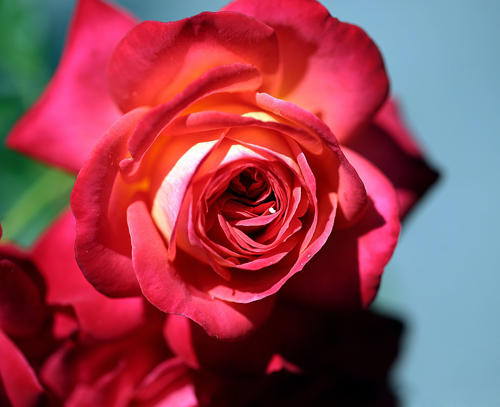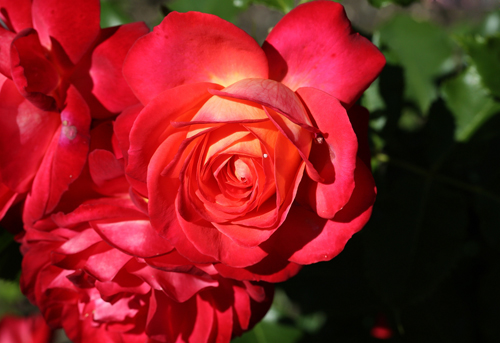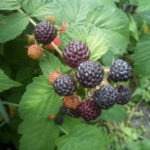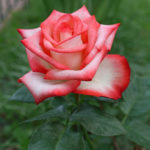Rose Midsummer
Most varietal roses are admired by those who admire them. Well, some varieties, strewn with delicate flowers, are capable of completely delighting a person. You will experience exactly that feeling when you see the Midsummer variety. This expressive culture will certainly take its rightful place on your site!

History and description
Midsummer was obtained in 2007 from the German nursery Tantau. It belongs to the floribunda group, all representatives of which are compact in size (with the exception of a few weaving varieties), are distinguished by long flowering, and form flowers in clusters. Midsummer is perhaps the brightest representative of this group. The variety is striking in its beauty of large, 5 to 8 cm in diameter, double flowers with a bright orange-red-yellow color and a high center. Rose flowers are formed in small inflorescences, each consist of 30-40 petals and hold their shape for a long time. Their edges are painted in scarlet tones, the inner side is sustained in a golden-cream color scheme. This combination of shades endows the plant with amazing tenderness and indescribable charm.

The culture forms a bush that does not reach 1 meter in height. Its width varies from 50 to 60 cm. Erect shoots are supplied with juicy green leaves of medium size with a shiny surface. The stems of the plant are quite stable and do not bend either under the weight of snow caps or from lush umbrella-shaped inflorescences. On one shoot there can be 3-5 picturesque flowers with a light, pleasant aroma, and this despite the fact that the fragrance of floribunda is almost uncommon. The plant blooms continuously from June to mid-October. On the culture, there can be buds at the same time, completely blossoming and already wilted flowers. Due to the abundance of flowering, the leaves on the rose bush are sometimes practically invisible.

Midsummer is a hardy variety. It is resistant to frost, rain, summer heat, diseases caused by fungi and bacteria.
Features of growing and care
The noble beauty Midsummer should be placed in a moderately lit area, where in the midday hours of hot summer days it will be reliably protected from direct sunlight. The flower does not like drafts.
Roses are planted in spring or autumn in soil with a neutral pH. If using loam, add sand to the soil. When planting a flower in sandy soil, first introduce a little black soil into it. The planting hole is dug about 60 cm deep. A drainage layer of expanded clay is laid at the bottom of the hole, then a mixture of peat, humus and superphosphate is added.
Midsummer needs regular soil moisture. Watering should be done at intervals of 2-3 times a week. Water is used standing, not cold. After watering, the ground around the flower is loosened. To preserve moisture in the soil, you can resort to mulching the root zone.
Top dressing is carried out regularly, once every 1.5-2 weeks, alternating the introduction of organic and mineral fertilizers into the soil under the bush. It is not forbidden to feed the culture with a general mixture of concentrates. In September, it is advisable to fertilize the bush with potash fertilizer to increase winter hardiness.
All floribundas need gentle pruning. The same goes for Midsummer. The plant is relieved only of diseased stems and thinning of the overgrown bush is carried out.
In regions with a harsh climate, a delicate rose should be covered for the winter. For insulation, straw, hay, spruce branches are used.
Use cases
The spectacular Midsummer flower is widely used in landscape design. Ornamental shrubs are planted as flower borders. They are also used to form hedges.The variety adorns group mixed plantings with roses of other varieties and herbaceous perennials, as well as building facades. It can be planted separately, but then it is better in the foreground of the site, so that delicate flowers of bright shades attract the eyes. Shoots with lush inflorescences will be appropriate as part of a flower bouquet, since they retain their freshness for a long time. Midsummer is also an excellent container variety, so you can safely grow it indoors.









As for the "beauty", I did not notice it. In the first year, it bloomed in mid-July, in the second - the same thing. Maybe she was beautiful for one day, but very quickly the flowers turned into dirty pink rags with yellow spots and stayed in this form for two weeks until I cut them off. True, there were many flowers. I gave it to good hands, maybe it will be corrected there.
I bought this rose for the balcony. I took it at random, just the seller advised. Very happy. I fell in love, became attached. In the second year there was a beautiful bush already. She spent the winter in the entrance, which is not heated, but in vain, she woke up early. I had to break off the sprouts. I had it for two years, spent the winter at the entrance for two years, but at the end of spring, due to my carelessness, it dried out. This year I bought the same variety because I was happy. I will try wintering on the balcony.